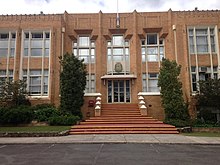
A secondary school or high school is an institution that provides secondary education. Some secondary schools provide both lower secondary education (ages 11 to 14) and upper secondary education (ages 14 to 18), i.e., both levels 2 and 3 of the ISCED scale, but these can also be provided in separate schools. There may be other variations in the provision: for example, children in Australia, Hong Kong, and Spain change from the primary to secondary systems a year later at the age of 12, with the ISCED's first year of lower secondary being the last year of primary provision.
In the United States, most local secondary education systems have separate middle schools and high schools. In the United Kingdom, most state schools and privately funded schools accommodate pupils between the ages of 11 and 16 or between 11 and 18; some UK private schools, i.e. public schools, admit pupils between the ages of 13 and 18.[1][2][3]
Secondary schools follow on from primary schools and prepare for vocational or tertiary education. In high and middle income countries, attendance is usually compulsory for students at least until age 16. The organisations, buildings, and terminology are more or less unique in each country.[4][5]
- ^ "The British Education System". The Headmasters' and Headmistresses' Conference. Archived from the original on April 25, 2019. Retrieved January 28, 2022.
Most pupils begin their secondary education at the age of 11 (Year 7), but in some HMC schools pupils join the school at 13+ (Year 9).
- ^ "Entry to Eton". Eton College. Archived from the original on December 14, 2021. Retrieved January 28, 2022.
... Eton College, a boarding school for boys aged between 13 and 18.
- ^ "Admissions". Harrow School. Archived from the original on January 28, 2022. Retrieved January 28, 2022.
Each year, the School admits about 160 boys into Year 9, in the September following their 13th birthday...
- ^ "International Standard Classification of EducationI S C E D 1997". www.unesco.org. 11 April 2013. Archived from the original on 2017-03-19. Retrieved 2017-03-12.
- ^ Iwamoto, Wataru (2005). "Towards a Convergence of Knowledge Acquisition and Skills Development" (PDF). uis.unesco.org. UNESCO. Archived from the original (PDF) on 2017-05-25. Retrieved 11 March 2017.